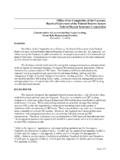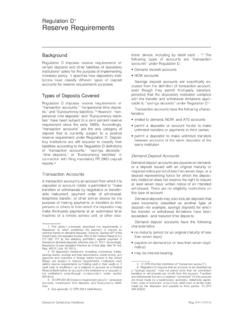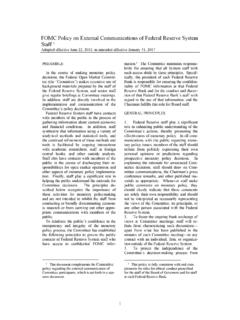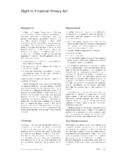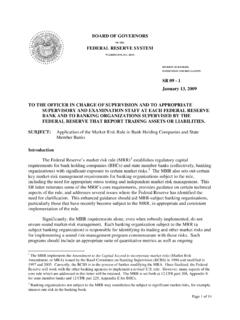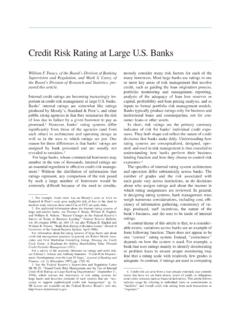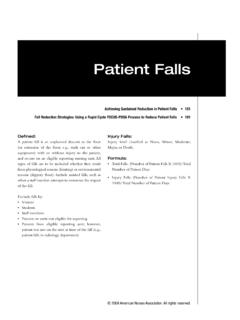Transcription of The Fedwire Funds Service Assessment of …
1 The Fedwire Funds Service Assessment of Compliance with the Core Principles for Systemically Important Payment Systems Revised July 2014 Table of Contents List of 2014 Revisions 4 Executive Summary 5 0 General Background 7 Brief History 7 Operations 8 Fedwire Use 10 1 Core Principle I: Legal Basis 11 Assessment of Compliance 11 General Statutes and Regulations 11 Federal Reserve Act 11 Federal Reserve Regulation J 11 Governing Agreements 13 Other Applicable Laws 13 2 Core Principle II: Understanding Financial Risks 15 Assessment of Compliance 15 Disclosure of Rules and Procedures 15 Financial Risks in Fedwire 15 Federal Reserve Policy on Payment System Risk 16 Operating Circular 6 ( Funds Transfers through Fedwire ) 16 Notification of Operating Hour Extensions and Operational Outages 17 3 Core Principle III.
2 Management of Financial Risks 18 Assessment of Compliance 18 Credit Risk 18 Credit Risk to Participants 18 Credit Risk to the Central Bank 18 Liquidity Risk 18 Liquidity Risk to Participants 18 Liquidity Risk to the Central Bank 19 Managing Credit and Liquidity Risks 19 Policies and Procedures for Managing Credit and Liquidity Risks 19 Tools for Managing Credit and Liquidity Risks 21 4 Core Principle IV: Prompt Final Settlement 23 Assessment of Compliance 23 Final and Irrevocable Settlement 23 Rejected Transfers and Error Handling 23 Bankruptcy 23 5 Core Principle V: Settlement in Multilateral Net Systems 24 2 6 Core Principle VI: Settlement Assets 25 Assessment of Compliance 25 7 Core Principle VII: Security and Operational Reliability 26 Assessment of Compliance 26 Security Policy and Controls 26 Operational Reliability 26 Business Continuity 27 8 Core Principle VIII: Efficiency 28 Assessment of Compliance 28 Economic Benefits 28 Pricing Policy and Competition 28 Cost Efficiency Measures 29 Service Practicality 29 User Consultations 30 Changes and Reforms in Process 31 9 Core Principle IX.
3 Access Criteria 32 Assessment of Compliance 32 Access to Fedwire 32 Access to an Account at the Federal Reserve 32 Termination of Access 32 10 Core Principle X: Governance 33 Assessment of Compliance 33 Policy and Decision Making Structure 33 Board of Governors 33 Federal Reserve Banks 34 Federal Reserve Bank Committees 35 Supervision and Audit 36 Board Supervision 36 External Audit 36 Federal Reserve Bank Internal Audit 36 Consultation Process 37 11 Conclusion 38 Assessment of Compliance 38 3 Executive Summary The international financial community has worked over time on initiatives to strengthen the global financial infrastructure.
4 As one of these initiatives, the Committee on Payment and Settlement Systems (CPSS) of the central banks of the Group of Ten countries developed the Core Principles for Systemically Important Payment Systems (Core Principles) to serve as guidelines for the design and operation of safe and efficient systemically important payment systems The Board of Governors of the Federal Reserve System (the Board) has incorporated these principles into the Federal Reserve Policy on Payment System Risk (PSR policy).2 This Assessment has been conducted pursuant to part I of the PSR policy. Effective financial systems depend on safe and efficient payment systems, particularly systemically important payment systems.
5 Systemically important payment systems can transmit economic shocks across markets and international borders. Poorly designed or operated payment systems can exacerbate economic disturbances, while well-managed systems help minimize these disturbances. As a real-time gross settlement (RTGS) system for the United States and the dollar, the Federal Reserve Banks Fedwire F unds Service plays a critical role in the implementation of United States monetary policy through the settlement of domestic money market The Fedwire Funds Service is also used for time-critical payments such as the settlement of commercial payments and financial market transactions, and for the funding of other systemically important financial market infrastructures.
6 The Federal Reserve is the central bank of the United States and includes the Board and the 12 regional Reserve Banks. The Federal Reserve seeks to foster the safety, efficiency, and accessibility of the Fedwire Funds Service and other payment systems in the United States. As a systemically important payment system, the Fedwire Funds Service should meet or exceed the international standards for such systems. Furthermore, the Federal Reserve recognizes that critical Reserve Bank payment and settlement 1 Committee on Payment and Settlement Systems, Core Principles for Systemically Important Payment Systems, Bank for International Settlements, January 2001. The Core Principles are available at Systemic importance is defined in paragraph In April 2012, CPSS and the Technical Committee of the International Organization of Securities Commissions (IOSCO) published the Principles for Financial Market Infrastructures (PFMIs), which updated, harmonized, strengthened, and replaced the existing CPSS and IOSCO risk-management standards, including the Core Principles with respect to payment systems.
7 2 In January 2014, the Board proposed revisions to part I of its PSR policy in light of the international risk-management standards in the PFMIs. Once the PFMIs are adopted into Board PSR policy, the Fedwire Funds Service will be expected to comply with those standards applicable to central bank-operated payment systems. 3 Fedwire is a registered Service mark of the Federal Reserve Banks. 5 0 General Background The Fedwire Funds Service is an RTGS system owned and operated by the Reserve Banks that enables participants to make final payments in central bank money. The Fedwire Funds Service consists of a set of computer applications that route and settle payment In addition to settling payment orders, the Fedwire Funds Service and related applications review payment orders for syntax errors, query and update account balances, and notify participants of related credits and debits to their accounts.
8 The Fedwire Funds Service is supported by a national communications network. An institution that maintains an account with a Reserve Bank generally can become a participant of the Fedwire Funds Service . Participants use the Fedwire Funds Service to instruct a Reserve Bank to debit Funds from the participant s own Reserve Bank account and credit the Reserve Bank account of another The Fedwire Funds Service processes and settles payment orders individually throughout the operating day. Payment to the receiving participant over the Fedwire Funds Service is final and irrevocable when the amount of the payment order is credited to the receiving participant s account or when the payment order is sent to the receiving participant, whichever is earlier.
9 Participants of the Fedwire Funds Service send payment orders to a Reserve Bank on line, by initiating an electronic message, or off line, via telephone. Payment orders must be in the proper syntax and meet the relevant security controls. An institution sending payment orders to a Reserve Bank is required to have sufficient Funds , either in the form of account balances or overdraft capacity, or a payment order may be rejected. Brief History The Reserve Banks developed the Fedwire Funds Service to improve the safety and efficiency of the interbank settlement In the early 1900s, settlement of interbank payment obligations often involved the physical delivery of cash or gold to counterparties, which was both risky and costly.
10 To mitigate these risks, in 1918, the Reserve Banks introduced a dedicated Funds transfer network featuring a Morse code system that connected the 12 Reserve Banks, the Board, and the United States Department of the Treasury. The key feature of this arrangement was the ability to transfer balances held at the Reserve Banks using a secure communications network. This feature remains the foundation of Fedwire Funds Service operations. 5 The definition of a payment order is in subpart B of the Board s Regulation J (12 CFR 210). The Code of Federal Regulations is available at 6 Except as provided in Operating Circular 1, an institution may maintain only a single master account with only the Reserve Bank in whose District the institution is located.
